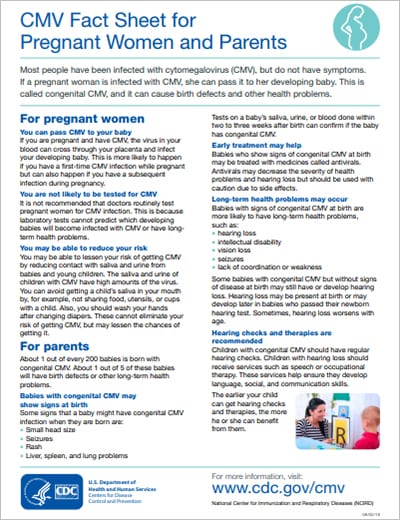 |
| CMV warning sign produced by Rebekah Hall of the Idaho CMV Advocacy Project |
Every year, 8 - 20% of caregivers/teachers contract CMV according to the American Academy of Pediatrics, which recommends that caregivers/teachers be counseled about CMV by their healthcare providers and daycare center directors. Saunders, the author of "The Danger of Spreading CMV: How We Can Protect Our Children" (ChildCare Aware of America, 2017), is launching the Project in June in honor of National Cytomegalovirus Awareness Month. The “ChildCare Providers Fighting CMV Project” provides a free online CMV prevention tool kit, which includes bathroom sink signs, the color-me-in fairytale, Once Upon a Placemat: A Table Setting Tale, and a PowerPoint presentation to teach schools and families how to “share a meal, not the germs."
- “Despite being the leading cause of mental retardation and disability in children, there are currently no national public awareness campaigns to educate expecting mothers about congenital CMV” states Clinical Advisor in “Educate pregnant women to prevent congenital CMV” (2014).
- Only 18.5% of licensed “in-home” daycare providers surveyed have heard of CMV and “Providers do not know how to appropriately sanitize surfaces to reduce spread of disease.” Many use diaper wipes to clean surfaces, which do not sanitize. “Increasing risk perception is important because providers may not be concerned about taking measures to reduce the probability of infection if they feel that they are at low risk” (Thackeray et al., 2016).
- Only a few states, such as Utah and Idaho, are providing CMV prevention education for their child care workers. Other countries, Germany and Queensland, Australia, have a very definite protocol to protect their child care workers.
- According to the March of Dimes, “As many as 7 in 10 children (70 percent) between 1 and 3 years of age who go to day care may have CMV. They can pass it on to their families, caretakers and other children.”
- “61 % of children under the age of 5 are cared for in a child care facility...Intervening with child care providers and parents through child care facilities are key opportunities to reduce prevalence of CMV infection and other diseases.” (Thackeray et al., 2016).
- Bag (paper or reusable insulated bag).
- Plate, cup, napkin, fork, spoon, knife.
- Crayons or washable markers.
- Placemat with tableware characters (free pdf for coloring and possible laminating).
- Picnic food (homemade or prepackaged that would use all utensils, such as peanut butter, crackers, applesauce and cake).
- Hand sanitizer or sanitizing wipes.
- Sink hand-washing sign and tri-fold flyer on CMV prevention to take home.
- If funds are available, give a child their own bound copy of Once Upon a Placemat: A Table Setting Tale to color and share with their families so their parents can reinforce the table-setting lesson and learn how to prevent CMV, the #1 birth defects virus, as well as other diseases (book available on Amazon for $5.38).
Like Saunders, Rachels was a childcare provider unaware of CMV until it was too late to protect her baby. Their stories are told in Chapter 1 of the book, Help Childcare Providers Fight CMV, which can be viewed by clicking on the "Look inside" feature on Amazon at:
https://www.amazon.com/Help-Childcare-Providers-Fight-CMV/dp/1984328697/ref=sr_1_2?s=books&ie=UTF8&qid=1519049495&sr=1-2&dpID=41hSTpYB1CL&preST=_SY291_BO1,204,203,200_QL40_&dpSrc=srch












